Multiple rocket launchers in WWII
 Bashny.Net
Bashny.Net
Female name Katyusha entered the history of Russia and in world history as the name of one of the most feared weapons of World War II.
At the same time none of the weapons he was not surrounded by a veil of secrecy and disinformation ...
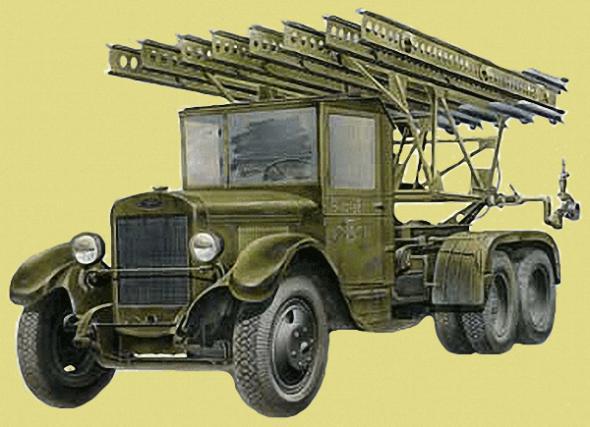
HISTORY
How our fathers commanders no secret materiel "Katyusha", it is already a few weeks after the first combat use came into the hands of the Germans, and ceased to be a secret. But the history of the "Katyusha" was kept for many years, "seven seals" both because of the ideological and the ambitions of the designers.
The first question - why rocket artillery was used only in 1941? After powder rockets used by the Chinese even a thousand years ago. In the first half of the XIX century rockets are widely used in European armies (V. Congreve rockets, A. Zasyadko, K. Konstantinov and others).
Rocket launchers the beginning of the XIX century. W. Congreve (a) and J. Kosinski (b)
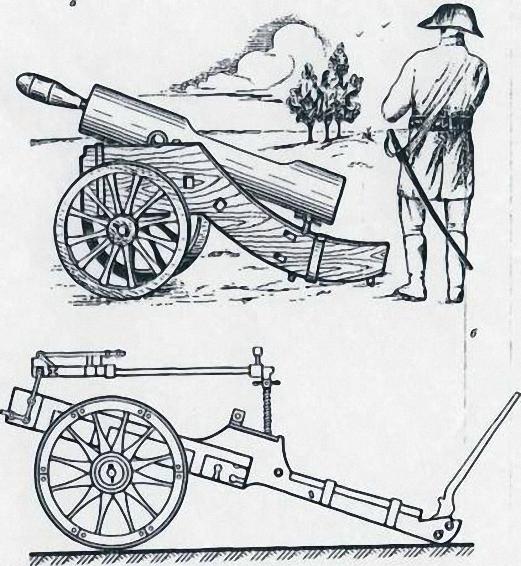
Alas, combat use of missiles was limited by their great dispersal. Initially used for the stabilization of long poles of wood or iron - "tails." But the effectiveness of such missiles were only to engage area targets. So, for example, in 1854 the Anglo-French with rowing barkazov fired missiles Odessa, and Russian in 50-70-ies of the XIX century - Central Asian city.
But with the introduction of rifled guns powder rockets are an anachronism, and between the years 1860-1880, they are removed from service all European armies (in Austria - in 1866, in England - in 1885, in Russia - in 1879-m). In 1914, the armies and navies of all countries were only flares. Nevertheless, Russian inventors are constantly appealed to the Chief Artillery Administration (GAU) to project combat missiles. Thus, in September 1905 the committee rejected the artillery high-explosive rockets. The warhead of this missile was packed with gun-cotton, and used as a fuel is not black and smokeless powder. And the fellows of GAC not even tried to work out an interesting project, and its shelf with a threshold. It is interesting that the designer was ... monk Kirik.
Only during the First World War revived interest in missiles. Three main reasons for this. First, the slow-burning gunpowder were created, which allowed to dramatically increase the speed of flight and firing range. Accordingly, with an increase in speed of flight became possible to effectively use the wing and stabilizers to improve the accuracy of shooting.
The second reason is the need to create a powerful weapon for the airplanes of World War I - "flying etazherok».
And finally, the most important reason - the rocket is best suited as a means of delivering chemical weapons. Chemical shells
More June 15, 1936 the head of the chemical control of the Red Army corps engineer J. Fishman presented the report of the Director RNII military engineer 1st Rank I. Kleimenova and Head of the 1st Division of the 2nd rank military engineer K. Glukhareva on preliminary tests 132/82 mm chemical rocket minute short range . This ammunition complement 250/132-mm chemical short-range mine, which tests completed by May 1936.
Missile M-13.
Projectile M-13 consists of a head and body. The head has a shell and a warhead. In front of the head is fixed fuse. The case provides the flight of the rocket projectile consists of lining, the combustion chamber, nozzles and Stability - Ator. In front of the combustion chamber dis - olozheny two electric igniter powder. On the outer surface of the shell of the combustion chamber there are two screwed on the thread guide pins that serve to hold the rockets in the guide systems. 1 - a lock ring fuse, 2 - fuse GVMZ, 3 - checker detonator 4 - bursting charge, 5 - the head part 6 - combustible - menitel, 7 - the bottom of the camera, 8 - the guide pin, 9 - rocket propellant charge 10 - missile units, 11 - grate 12 - critical section of the nozzle 13 - Nozzle 14 - stabilizer 15 - check the remote detonator, 16 - remote detonator AGDT 17 - igniter.

Thus, "RNII finished all preliminary development of the establishment of a powerful means of short-range chemical attack, expects from you a general opinion on testing and indicate the need for further work in this direction. For its part, RNII considers it necessary now to give gross development order for production of RHM-250 (300 units) and RHM-132 (300 pieces) for the purpose of firing ranges and military trials. The rest of the pre-test five pieces of RHM-250, three of which - at the Central Chemical Site (Art. Prichernavskaya) and three RHM-132 can be used for additional testing on your instructions ».
The experimental setup of M-8 on the tank
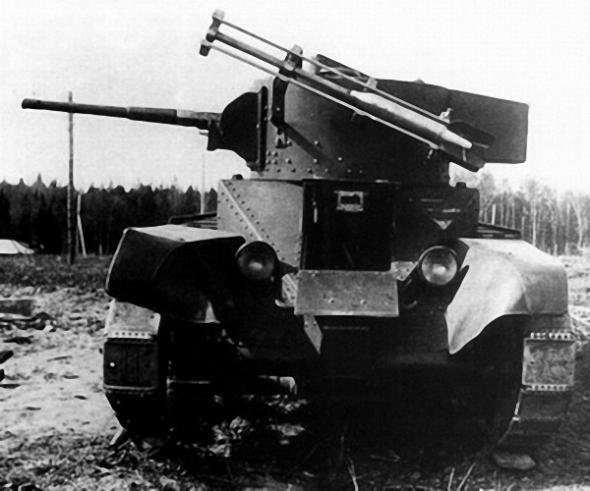
According to the report RNII from operating activities for 1936 on the theme number 1 were made and tested samples of 132-mm and 250-mm rockets with chemical warhead capacity of 6 and 30 liters agents. Tests carried out in the presence of Chief VOHIMU Red Army, gave satisfactory results and have received a positive evaluation. But VOHIMU has done nothing to implement these shells in the Red Army gave RNII new jobs missiles with a longer range.
The first prototype of the "Katyusha" (BM-13) mentioned January 3, 1939 in a letter to People's Commissar for Defense Industry Mikhail Kaganovich his brother - Deputy Chairman of People's Commissars of Lazar Kaganovich: "In October 1938, the automotive mechanized rocket launcher for the organization of a sudden chemical attack on the enemy mainly it passed factory tests on shooting Sofrinsky control test artillery range, and is currently undergoing field testing in the Central military chemical landfill in Prichernavskoy. "
Experimental set-up M-13 on the trailer
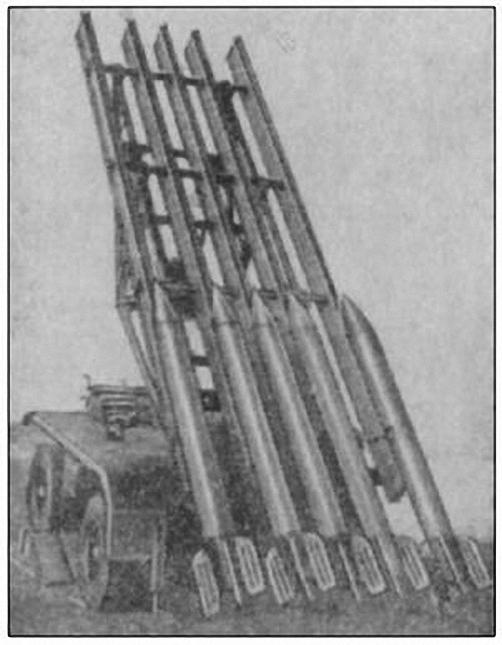
We call attention to the future customers "Katyusha" - the military chemists. Funding for the work is also conducted through Himupravleniya and finally missile warheads exclusively chemical.
132-mm chemical munitions RHS-132 were tested in the fire artillery range Pavlograd August 1, 1938. The fire was single shells and series 6 and 12 shells. The duration of a complete series of firing ammunition did not exceed 4 seconds. During this time, the target area has reached 156 liters RH, equivalent to 152 mm caliber artillery was equivalent to 63 artillery shells while shooting 21 three-gun volley of batteries or 1, 3 artillery regiment under the condition that the fire was unstable agents. The tests focused on the fact that metal consumption by 156 liters of RH by firing rockets was 550 kg, while when firing 152-mm chemical shells metal weight was 2370 kg, ie 4, 3 times.
The test report stated: "Car mechanized rocket launcher to a chemical attack during the test showed significant advantages over artillery systems. On the three-ton machine is installed, the ability to lead as a single fire, and a series of 24 shots in 3 seconds. Speed of movement - for regular truck. Translation from marching into combat position takes 3-4 minutes. Firing - from the driver or from the shelter.
The first pilot installation of the M-13 on chassis
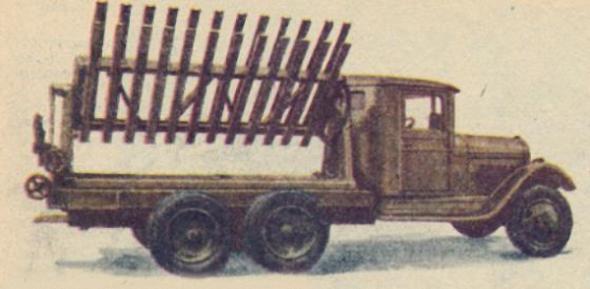
One warhead RHS (reactive chemical projectile. - "NVO") accommodates 8 l OB, and artillery shells of similar caliber - only 2 liters. To create a dead zone in the area of 12 hectares only one volley with three trucks, which replaces the 150 howitzer artillery regiment or 3. At a distance of 6 km area of infection RH one volley of 6-8 hectares ».
I note that the Germans and their multiple rocket launchers are also prepared exclusively for chemical warfare. So, at the end of the 1930s, the German engineer Nebel was designed by 15-cm and six-barreled rocket tube installation, which the Germans called six-barreled mortar. Tests mortars were launched in 1937. The system was named "15 cm smoke mortar type" D ". In 1941 it was renamed 15 cm Nb.W 41 (Nebelwerfer), ie 15 cm mortar smoke mod. 41. Naturally, their main purpose was not a smoke screen, and shooting rockets stuffed with toxic substances. Interestingly, the Soviet soldiers were called 15 cm Nb.W 41 "Vanya", by analogy with the M-13, called "Katyusha».
Nb.W 41

The first launch of a prototype "Katyusha" (design Tikhomirov and Artemyev) took place in the USSR, March 3, 1928. Flight distance 22 7 kg rocket reached 1300 m, and as the launcher was used mortar system Van Derain.
The caliber of our launch of the Great Patriotic War - 82 mm and 132 mm - was determined not more than a diameter of the motor propellant sticks. Seven 24-mm propellant sticks tightly packed into the combustion chamber gives a diameter of 72 mm, the thickness of the chamber walls - 5 mm, hence the diameter (caliber) rockets - 82 mm. Seven more thick (40 mm) pieces in the same way gives 132 mm caliber.
The most important issue in the design of rockets became a way to stabilize. Soviet designers chose feathered missiles and adhere to this principle before the end of the war.
In the 1930s, it was tested missiles with a ring stabilizer, not beyond the dimensions of the shell. These missiles can be fired from the tubular rails. But tests have shown that by means of annular stabilizer impossible to achieve stable flight.
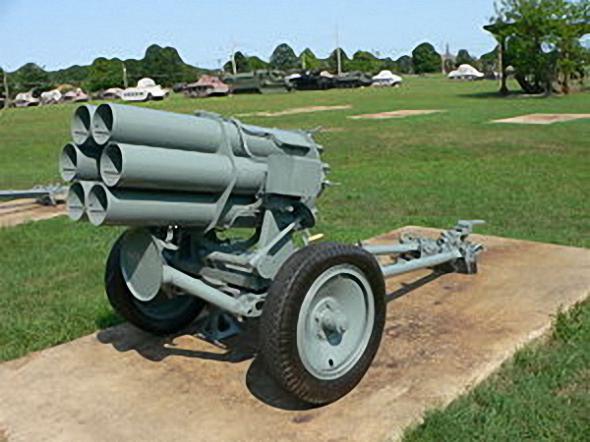
Then they had shot 82-mm rockets in a big four-bladed tail 200, 180, 160, 140 and 120 mm. The results were quite certain - with decreasing amplitude decreased feathering flight stability and accuracy. The plumage is a big 200 mm shifts the center of gravity of the projectile back, which also impairs the stability of the flight. Relief feathers by reducing the thickness of the stabilizer blades caused strong vibrations of the blades until their destruction.
As a start-up for the feathered missiles were taken flute guides. Experiments have shown that what they are longer, the higher the accuracy of missiles. Length of 5 m for RS-132 becomes maximum due to restrictions on rail dimensions.
Note that Germans stabilized their missiles until 1942 only rotation. In the Soviet Union also tested the missile turbojet, but mass production, they did not. As we are often the cause of failures during tests not explained wretchedness performance and inefficiency concept.

The first salvo
Whether we like it or not, the first time in World War II multiple rocket launchers used the Germans June 22, 1941 near Brest. "And the arrow showed 03.15, heard the command," Fire! "And began a devilish dance. Came shake the earth. The nine panels of the 4th regiment of special purpose mortars also contributed to the infernal symphony. For half an hour in 2880 shells whistling raced over the Bug and hit the town and the fortress on the eastern bank of the river. Heavy 600 mm mortars and 210-mm guns of the 98th Artillery Regiment rained volleys to strengthen its stronghold and hit point targets - Soviet artillery positions. It seemed, on the strength of a stone will be left ».
So the historian Karel Paul described the first use of a 15-cm rocket mortars. In addition, in 1941 the Germans used heavy 28-cm high-explosive and incendiary 32-cm turbojet projectiles. Shells were nadkalibernye and had one engine powder (the diameter of the motor 140 mm).
28 cm blast mine in direct contact with the stone house it completely destroyed. Mina successfully destroyed shelters field type. Live targets within a few tens of meters amazed blast. Splinters were flying mines at a distance up to 800 m. The head portion of the liquid contained 50 kg of TNT, or ammatola mark 40/60. Curiously, and 28-cm and 32-cm German mines (rocket) transported and launched from a simple wooden box-type closure.
The first is the use of "Katyusha" was held July 14, 1941. Battery Captain Ivan A. Flerov produced seven launchers, two volleys of Orsha railway station. The emergence of "Katyusha" was a complete surprise to the leadership of the Abwehr and Wehrmacht. General Command of the Army in Germany August 14 notifies his troops: "Russian have automatic multicore flamethrower gun ... Shot produce electricity. During the shot is formed smoke ... The capture of guns reported immediately. " Two weeks later there was a directive, entitled "Russian cannon Meta raketoobraznye shells." It said: "... The troops convey the application of new Russian weapons, firing rockets. From a single installation for 3-5 seconds can be made a large number of shots ... In every appearance of these instruments should bring the general, commander of the chemical troops of the Supreme Command, on the same day. "

Where did the name "Katyusha", is not known. A curious version of Peter Hook, "and at the front, and then, after the war, when acquainted with the archives, talked to veterans, read their statements in the press, I have met very different explanations of how dangerous weapon received the maiden name. Some believed that the beginning was the letter "K", which was put Voronezh Comintern on its products. The troops went to a legend that called Guards mortars called dashing girl-partisan, destroyed a lot of the Nazis ».
When polygon firing fighters and commanders have asked the representative of the State Agrarian University called "real" name of fighting installations, he advised: "Call the installation as usual cannon. It is important to preserve the secrecy ».
Soon the "Katyusha" announced a younger brother named "Luka". In May 1942 a group of officers of the Main Control Arms has developed a shell M-30, in which a rocket engine from the M-13 joined nadkalibernaya powerful warhead, made in the form of an ellipsoid, with a maximum diameter of 300 mm.
Installation of the M-30 "Luca»

After successful field tests, June 8, 1942 the State Defense Committee (GKO) issued a decree adopting the M-30 and the beginning of its serial production. In Stalin's time, all the important problems were solved quickly and by July 10, 1942 created the first 20 guards mortar battalions of the M-30. Each of them had trehbatareyny composition quadruply battery has 32 single-stage launchers. Divisional volley was respectively 384 projectile.
The first combat use of the M-30 took place in the 61 th Army on the Western Front in the town of Belev. Day on June 5 the German positions in Annino and upper Doltsah with thundering roar hit two regimental volley. Both villages were razed to the ground, after which the infantry took them without a loss.
Power projectiles "Luka" (M-30 and M-31 modification) makes a great impression on the enemy, and our soldiers. On the "Luka" on the front, there were many different assumptions and fabrications. One legend was that if the warhead missiles packed with some special, very powerful explosive, capable of burning all in the area of the break. In fact, the warheads used conventional explosives. The exceptional effect of the shells "Luka" was achieved at the expense of burst shooting. With the simultaneous or nearly simultaneous explosion of the whole group of shells into effect the law of addition of pulses of shock waves.
Installing M-30 "Luka" Studebaker chassis

M-30 shells were explosive fragmentation, chemical and incendiary warhead. However, mostly used high explosive warhead. Behind the characteristic form the head of the M-30 veterans called him "Luke Mudischevym" (the hero of the poem Barkov). Naturally, this nickname, unlike replicated "Katyusha", official media prefer not to mention. "Luke," like the German 28-cm and 30-cm projectiles launched from the closure of wooden box in which he was delivered from the factory. Four, and later eight of these boxes were placed on a special frame, resulting in a simple launcher.
Needless to say that after the war, journalistic and literary brethren to the place and not the place to commemorate "Katyusha", but chose to forget her much more formidable brother "Luka." In 1970-1980-ies at the first mention of "Luke," veterans was surprised asked me: "Do you know where something? You're not at war. "
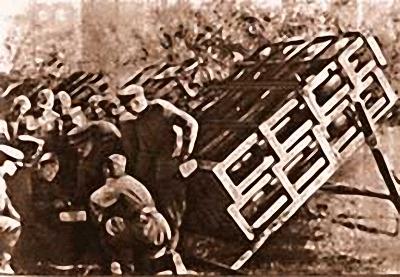
MYTH ANTITANK
"Katyusha" was a first-class weapons. As often happens, the founding fathers of the commanders wanted it to become a universal weapon, including anti-tank weapons.
Orders are orders, and headquarters rushed triumphant. If you believe the secret edition of "Field reactive artillery in World War II" (Moscow, 1955), at the Kursk two days in three episodes of "Katyusha" was destroyed 95 enemy tanks!
Source:
At the same time none of the weapons he was not surrounded by a veil of secrecy and disinformation ...

HISTORY
How our fathers commanders no secret materiel "Katyusha", it is already a few weeks after the first combat use came into the hands of the Germans, and ceased to be a secret. But the history of the "Katyusha" was kept for many years, "seven seals" both because of the ideological and the ambitions of the designers.
The first question - why rocket artillery was used only in 1941? After powder rockets used by the Chinese even a thousand years ago. In the first half of the XIX century rockets are widely used in European armies (V. Congreve rockets, A. Zasyadko, K. Konstantinov and others).
Rocket launchers the beginning of the XIX century. W. Congreve (a) and J. Kosinski (b)

Alas, combat use of missiles was limited by their great dispersal. Initially used for the stabilization of long poles of wood or iron - "tails." But the effectiveness of such missiles were only to engage area targets. So, for example, in 1854 the Anglo-French with rowing barkazov fired missiles Odessa, and Russian in 50-70-ies of the XIX century - Central Asian city.
But with the introduction of rifled guns powder rockets are an anachronism, and between the years 1860-1880, they are removed from service all European armies (in Austria - in 1866, in England - in 1885, in Russia - in 1879-m). In 1914, the armies and navies of all countries were only flares. Nevertheless, Russian inventors are constantly appealed to the Chief Artillery Administration (GAU) to project combat missiles. Thus, in September 1905 the committee rejected the artillery high-explosive rockets. The warhead of this missile was packed with gun-cotton, and used as a fuel is not black and smokeless powder. And the fellows of GAC not even tried to work out an interesting project, and its shelf with a threshold. It is interesting that the designer was ... monk Kirik.
Only during the First World War revived interest in missiles. Three main reasons for this. First, the slow-burning gunpowder were created, which allowed to dramatically increase the speed of flight and firing range. Accordingly, with an increase in speed of flight became possible to effectively use the wing and stabilizers to improve the accuracy of shooting.
The second reason is the need to create a powerful weapon for the airplanes of World War I - "flying etazherok».
And finally, the most important reason - the rocket is best suited as a means of delivering chemical weapons. Chemical shells
More June 15, 1936 the head of the chemical control of the Red Army corps engineer J. Fishman presented the report of the Director RNII military engineer 1st Rank I. Kleimenova and Head of the 1st Division of the 2nd rank military engineer K. Glukhareva on preliminary tests 132/82 mm chemical rocket minute short range . This ammunition complement 250/132-mm chemical short-range mine, which tests completed by May 1936.
Missile M-13.
Projectile M-13 consists of a head and body. The head has a shell and a warhead. In front of the head is fixed fuse. The case provides the flight of the rocket projectile consists of lining, the combustion chamber, nozzles and Stability - Ator. In front of the combustion chamber dis - olozheny two electric igniter powder. On the outer surface of the shell of the combustion chamber there are two screwed on the thread guide pins that serve to hold the rockets in the guide systems. 1 - a lock ring fuse, 2 - fuse GVMZ, 3 - checker detonator 4 - bursting charge, 5 - the head part 6 - combustible - menitel, 7 - the bottom of the camera, 8 - the guide pin, 9 - rocket propellant charge 10 - missile units, 11 - grate 12 - critical section of the nozzle 13 - Nozzle 14 - stabilizer 15 - check the remote detonator, 16 - remote detonator AGDT 17 - igniter.

Thus, "RNII finished all preliminary development of the establishment of a powerful means of short-range chemical attack, expects from you a general opinion on testing and indicate the need for further work in this direction. For its part, RNII considers it necessary now to give gross development order for production of RHM-250 (300 units) and RHM-132 (300 pieces) for the purpose of firing ranges and military trials. The rest of the pre-test five pieces of RHM-250, three of which - at the Central Chemical Site (Art. Prichernavskaya) and three RHM-132 can be used for additional testing on your instructions ».
The experimental setup of M-8 on the tank

According to the report RNII from operating activities for 1936 on the theme number 1 were made and tested samples of 132-mm and 250-mm rockets with chemical warhead capacity of 6 and 30 liters agents. Tests carried out in the presence of Chief VOHIMU Red Army, gave satisfactory results and have received a positive evaluation. But VOHIMU has done nothing to implement these shells in the Red Army gave RNII new jobs missiles with a longer range.
The first prototype of the "Katyusha" (BM-13) mentioned January 3, 1939 in a letter to People's Commissar for Defense Industry Mikhail Kaganovich his brother - Deputy Chairman of People's Commissars of Lazar Kaganovich: "In October 1938, the automotive mechanized rocket launcher for the organization of a sudden chemical attack on the enemy mainly it passed factory tests on shooting Sofrinsky control test artillery range, and is currently undergoing field testing in the Central military chemical landfill in Prichernavskoy. "
Experimental set-up M-13 on the trailer

We call attention to the future customers "Katyusha" - the military chemists. Funding for the work is also conducted through Himupravleniya and finally missile warheads exclusively chemical.
132-mm chemical munitions RHS-132 were tested in the fire artillery range Pavlograd August 1, 1938. The fire was single shells and series 6 and 12 shells. The duration of a complete series of firing ammunition did not exceed 4 seconds. During this time, the target area has reached 156 liters RH, equivalent to 152 mm caliber artillery was equivalent to 63 artillery shells while shooting 21 three-gun volley of batteries or 1, 3 artillery regiment under the condition that the fire was unstable agents. The tests focused on the fact that metal consumption by 156 liters of RH by firing rockets was 550 kg, while when firing 152-mm chemical shells metal weight was 2370 kg, ie 4, 3 times.
The test report stated: "Car mechanized rocket launcher to a chemical attack during the test showed significant advantages over artillery systems. On the three-ton machine is installed, the ability to lead as a single fire, and a series of 24 shots in 3 seconds. Speed of movement - for regular truck. Translation from marching into combat position takes 3-4 minutes. Firing - from the driver or from the shelter.
The first pilot installation of the M-13 on chassis

One warhead RHS (reactive chemical projectile. - "NVO") accommodates 8 l OB, and artillery shells of similar caliber - only 2 liters. To create a dead zone in the area of 12 hectares only one volley with three trucks, which replaces the 150 howitzer artillery regiment or 3. At a distance of 6 km area of infection RH one volley of 6-8 hectares ».
I note that the Germans and their multiple rocket launchers are also prepared exclusively for chemical warfare. So, at the end of the 1930s, the German engineer Nebel was designed by 15-cm and six-barreled rocket tube installation, which the Germans called six-barreled mortar. Tests mortars were launched in 1937. The system was named "15 cm smoke mortar type" D ". In 1941 it was renamed 15 cm Nb.W 41 (Nebelwerfer), ie 15 cm mortar smoke mod. 41. Naturally, their main purpose was not a smoke screen, and shooting rockets stuffed with toxic substances. Interestingly, the Soviet soldiers were called 15 cm Nb.W 41 "Vanya", by analogy with the M-13, called "Katyusha».
Nb.W 41

The first launch of a prototype "Katyusha" (design Tikhomirov and Artemyev) took place in the USSR, March 3, 1928. Flight distance 22 7 kg rocket reached 1300 m, and as the launcher was used mortar system Van Derain.
The caliber of our launch of the Great Patriotic War - 82 mm and 132 mm - was determined not more than a diameter of the motor propellant sticks. Seven 24-mm propellant sticks tightly packed into the combustion chamber gives a diameter of 72 mm, the thickness of the chamber walls - 5 mm, hence the diameter (caliber) rockets - 82 mm. Seven more thick (40 mm) pieces in the same way gives 132 mm caliber.
The most important issue in the design of rockets became a way to stabilize. Soviet designers chose feathered missiles and adhere to this principle before the end of the war.
In the 1930s, it was tested missiles with a ring stabilizer, not beyond the dimensions of the shell. These missiles can be fired from the tubular rails. But tests have shown that by means of annular stabilizer impossible to achieve stable flight.

Then they had shot 82-mm rockets in a big four-bladed tail 200, 180, 160, 140 and 120 mm. The results were quite certain - with decreasing amplitude decreased feathering flight stability and accuracy. The plumage is a big 200 mm shifts the center of gravity of the projectile back, which also impairs the stability of the flight. Relief feathers by reducing the thickness of the stabilizer blades caused strong vibrations of the blades until their destruction.
As a start-up for the feathered missiles were taken flute guides. Experiments have shown that what they are longer, the higher the accuracy of missiles. Length of 5 m for RS-132 becomes maximum due to restrictions on rail dimensions.
Note that Germans stabilized their missiles until 1942 only rotation. In the Soviet Union also tested the missile turbojet, but mass production, they did not. As we are often the cause of failures during tests not explained wretchedness performance and inefficiency concept.

The first salvo
Whether we like it or not, the first time in World War II multiple rocket launchers used the Germans June 22, 1941 near Brest. "And the arrow showed 03.15, heard the command," Fire! "And began a devilish dance. Came shake the earth. The nine panels of the 4th regiment of special purpose mortars also contributed to the infernal symphony. For half an hour in 2880 shells whistling raced over the Bug and hit the town and the fortress on the eastern bank of the river. Heavy 600 mm mortars and 210-mm guns of the 98th Artillery Regiment rained volleys to strengthen its stronghold and hit point targets - Soviet artillery positions. It seemed, on the strength of a stone will be left ».
So the historian Karel Paul described the first use of a 15-cm rocket mortars. In addition, in 1941 the Germans used heavy 28-cm high-explosive and incendiary 32-cm turbojet projectiles. Shells were nadkalibernye and had one engine powder (the diameter of the motor 140 mm).
28 cm blast mine in direct contact with the stone house it completely destroyed. Mina successfully destroyed shelters field type. Live targets within a few tens of meters amazed blast. Splinters were flying mines at a distance up to 800 m. The head portion of the liquid contained 50 kg of TNT, or ammatola mark 40/60. Curiously, and 28-cm and 32-cm German mines (rocket) transported and launched from a simple wooden box-type closure.
The first is the use of "Katyusha" was held July 14, 1941. Battery Captain Ivan A. Flerov produced seven launchers, two volleys of Orsha railway station. The emergence of "Katyusha" was a complete surprise to the leadership of the Abwehr and Wehrmacht. General Command of the Army in Germany August 14 notifies his troops: "Russian have automatic multicore flamethrower gun ... Shot produce electricity. During the shot is formed smoke ... The capture of guns reported immediately. " Two weeks later there was a directive, entitled "Russian cannon Meta raketoobraznye shells." It said: "... The troops convey the application of new Russian weapons, firing rockets. From a single installation for 3-5 seconds can be made a large number of shots ... In every appearance of these instruments should bring the general, commander of the chemical troops of the Supreme Command, on the same day. "

Where did the name "Katyusha", is not known. A curious version of Peter Hook, "and at the front, and then, after the war, when acquainted with the archives, talked to veterans, read their statements in the press, I have met very different explanations of how dangerous weapon received the maiden name. Some believed that the beginning was the letter "K", which was put Voronezh Comintern on its products. The troops went to a legend that called Guards mortars called dashing girl-partisan, destroyed a lot of the Nazis ».
When polygon firing fighters and commanders have asked the representative of the State Agrarian University called "real" name of fighting installations, he advised: "Call the installation as usual cannon. It is important to preserve the secrecy ».
Soon the "Katyusha" announced a younger brother named "Luka". In May 1942 a group of officers of the Main Control Arms has developed a shell M-30, in which a rocket engine from the M-13 joined nadkalibernaya powerful warhead, made in the form of an ellipsoid, with a maximum diameter of 300 mm.
Installation of the M-30 "Luca»

After successful field tests, June 8, 1942 the State Defense Committee (GKO) issued a decree adopting the M-30 and the beginning of its serial production. In Stalin's time, all the important problems were solved quickly and by July 10, 1942 created the first 20 guards mortar battalions of the M-30. Each of them had trehbatareyny composition quadruply battery has 32 single-stage launchers. Divisional volley was respectively 384 projectile.
The first combat use of the M-30 took place in the 61 th Army on the Western Front in the town of Belev. Day on June 5 the German positions in Annino and upper Doltsah with thundering roar hit two regimental volley. Both villages were razed to the ground, after which the infantry took them without a loss.
Power projectiles "Luka" (M-30 and M-31 modification) makes a great impression on the enemy, and our soldiers. On the "Luka" on the front, there were many different assumptions and fabrications. One legend was that if the warhead missiles packed with some special, very powerful explosive, capable of burning all in the area of the break. In fact, the warheads used conventional explosives. The exceptional effect of the shells "Luka" was achieved at the expense of burst shooting. With the simultaneous or nearly simultaneous explosion of the whole group of shells into effect the law of addition of pulses of shock waves.
Installing M-30 "Luka" Studebaker chassis

M-30 shells were explosive fragmentation, chemical and incendiary warhead. However, mostly used high explosive warhead. Behind the characteristic form the head of the M-30 veterans called him "Luke Mudischevym" (the hero of the poem Barkov). Naturally, this nickname, unlike replicated "Katyusha", official media prefer not to mention. "Luke," like the German 28-cm and 30-cm projectiles launched from the closure of wooden box in which he was delivered from the factory. Four, and later eight of these boxes were placed on a special frame, resulting in a simple launcher.
Needless to say that after the war, journalistic and literary brethren to the place and not the place to commemorate "Katyusha", but chose to forget her much more formidable brother "Luka." In 1970-1980-ies at the first mention of "Luke," veterans was surprised asked me: "Do you know where something? You're not at war. "

MYTH ANTITANK
"Katyusha" was a first-class weapons. As often happens, the founding fathers of the commanders wanted it to become a universal weapon, including anti-tank weapons.
Orders are orders, and headquarters rushed triumphant. If you believe the secret edition of "Field reactive artillery in World War II" (Moscow, 1955), at the Kursk two days in three episodes of "Katyusha" was destroyed 95 enemy tanks!
Source:
Tags
See also
"Call the fire itself": the doctrine 288th Art. Brigade
Technical Museum of AvtoVAZ in Togliatti
Reconstruction techniques of the Second World
Adult Toys
Armored Singapore (16 photos)
Museum and park complex AvtoVAZ (20 photos)
Submarine World
The most destructive weapon
Reactive artillery brigade MLRS "Smerch"
"Smerch": the engine - V12, 650 "horses"
















